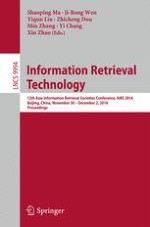2016 | Buch
Information Retrieval Technology
12th Asia Information Retrieval Societies Conference, AIRS 2016, Beijing, China, November 30 – December 2, 2016, Proceedings
herausgegeben von: Shaoping Ma, Ji-Rong Wen, Yiqun Liu, Zhicheng Dou, Min Zhang, Yi Chang, Xin Zhao
Verlag: Springer International Publishing
Buchreihe : Lecture Notes in Computer Science
